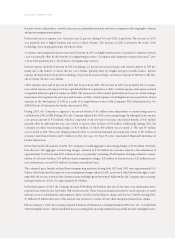American Express 2003 Annual Report Download - page 38
Download and view the complete annual report
Please find page 38 of the 2003 American Express annual report below. You can navigate through the pages in the report by either clicking on the pages listed below, or by using the keyword search tool below to find specific information within the annual report.
The Company believes allocating capital to its growing businesses with a return on risk-adjusted equity in excess of their
cost of capital will continue to build shareholder value. The Company’s philosophy is to retain earnings sufficient to enable
it to meet its growth objectives, and, to the extent capital exceeds investment opportunities, return excess capital to share-
holders. Assuming the Company achieves its financial objectives of 12 to 15 percent EPS growth, 18 to 20 percent return on
equity and 8 percent revenue growth, on average and over time, it will seek to return to shareholders an average of 65 per-
cent of capital generated, subject to business mix, acquisitions and rating agency requirements. The Company met or
exceeded all three of its financial objectives during 2003 and invested in two business acquisitions. During 2003, the Com-
pany returned to shareholders through dividends and share repurchases approximately 54 percent of capital generated.
Excluding the equity capital required to support the Threadneedle and Rosenbluth acquisitions, the Company returned 69
percent of capital generated in 2003. Since the inception of the Company’s current share repurchase program in 1994,
approximately 64 percent of capital generated has been returned to shareholders.
The Company maintains sufficient equity capital to support its businesses. Flexibility is maintained to shift capital among
business units as appropriate. For example, the Company may infuse additional capital into subsidiaries to maintain capi-
tal at targeted levels, which include consideration of debt ratings and regulatory requirements. These infused amounts can
affect both Parent Company capital and liquidity levels. The Company maintains discretion to manage these effects, includ-
ing the issuance of public debt or the reduction of projected common share buybacks. Additionally, the Company may trans-
fer short-term funds within the Company to meet liquidity needs, subject to and in compliance with various contractual
and regulatory constraints.
On September 30, 2003, the Company, through its AEFA segment, completed its acquisition of Threadneedle Asset Man-
agement Holdings LTD, one of the premier asset management organizations in the United Kingdom, for £340 million
(approximately $565 million at September 30, 2003 exchange rates). As a result, the Company acquired $3.6 billion of
owned assets, which were consolidated into the Company’s balance sheets, and $81.1 billion of assets under management.
Included in the assets under management are certain assets of Zurich Financial Services, U.K., which Threadneedle will
continue to manage for an initial term of up to eight years, subject to standard performance criteria. Additionally, in Octo-
ber 2003, the Company announced the completion of the acquisition of Rosenbluth International, a leading global travel
management company with more than $3 billion of annual travel volume.
Cash Flows
Cash Flows from Operating Activities
The Company generated net cash provided by operating activities in amounts greater than net income for the years ended
December 31, 2002 and 2001, primarily due to provisions for losses and benefits, which represent expenses in the
Consolidated Statements of Income but do not require cash at the time of provision. Similarly, depreciation and amortization
represents a non-cash expense.
Net cash provided by operating activities is lower in 2003 than 2002, as higher net income in 2003 was more than offset
by fluctuations in the Company’s operating assets and liabilities, primarily reflecting the purchase of securities in 2002, set-
tled in 2003. These accounts vary significantly in the normal course of business due to the amount and timing of various
payments. Net cash provided by operating activities was higher in 2002 than in 2001 due to higher net income and an
increase in accounts payable.
Management believes cash flows from operations, available cash balances and short-term borrowings will be sufficient to
fund the Company’s operating liquidity needs.
Cash Flows from Investing Activities
The Company’s investing activities primarily include funding TRS’ cardmember loans and receivables and AEFA’s Available-
for-Sale investment portfolio.
For the year ended December 31, 2003, net cash used in investing activities increased over the prior year primarily due to
an increased investment portfolio reflecting the cumulative benefit of sales of annuities, insurance and certificate products
(p.36_axp_ financial review)
























